|

by Harrison Koehli
from
Sott Website
Spanish version
Part 1
Prophecy, Prediction, and Portents of Things to
Come
27 October 2011
Note:
This is the first in
a series of articles on the track record of the
Cs (Cassiopaeans), those sometimes sarcastic and
always insightful perhaps-future-intelligences
and subject of the Cassiopaean Experiment.
We aim to present
those instances of statements that have proven
themselves to be accurate, to greater or lesser
degrees, as a result of subsequent events,
research and discoveries.
"Speak My
Will, Make Yourself a Prophet!"
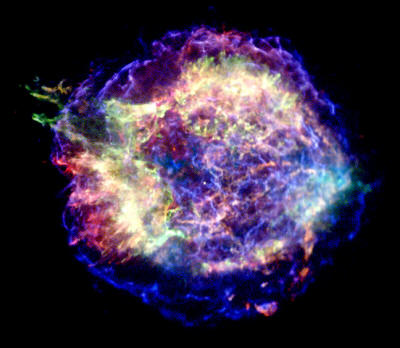
© Chandra
Cassiopeia A, a supernova remnant, is approximately 300 years 'old'
and has the
distinction of being the strongest radio source
that is observable
outside our solar system.
At any given point in time there seems to be at least one charlatan
running around predicting the imminent end of the world.
In 2011, radio evangelist Harold Camping
predicted the world's faithful would be 'Raptured' on 21 May 2011.
Of course, the date turned out to be a total dud, prompting Camping
to 'revise' his prediction to October 21. Needless to say, at the
time of writing we weren't holding our breath, and with good reason.
We might have passed out and missed another apocalyptic non-event!
But is there such a thing as valid prophecy or prediction of future
events? The results of the
Cassiopaean
Experiment suggest that there is indeed such a thing, and more
(e.g., remote access to unconventional knowledge, whether obscure or
just previously unheard of).
But the Cs have presented a very unique
take on the subject of prediction. It is intimately tied with their
cosmology and their view on 'time'. According to the Cs, our
universe is a 'free will' universe and time is not a strictly linear
'one-off' phenomenon. That means the future is open.
More on
that below.
Most predictions are based on a pretty simplistic, and probably
completely false, view of reality. According to this mechanistic
idea, the universe was originally set in motion at some imaginary
'beginning' point in time by some equally imaginary 'first cause'.
Religions have called this first cause 'God' while scientists have
deemed it the 'Big Bang'. Once the machine has been set in motion,
it obeys physical laws and plays itself out like clockwork.
Theoretically, with enough data, every event in this mechanistic
chain of cause and effect can be predicted. So when some prophet
gives a prediction of a future event, he or she is basically
operating on the assumption that because 'God' or some other divine
being is omniscient and can see how everything will play itself out
(and assuming this being actually exists, and that it is not simply
pulling a cosmic practical joke on its subject), it's got to be
right.
But things aren't that simple.
As we see in the cases of
Harold Camping and countless others, their
predictions are, more often than not, completely wrong. In such
cases, the rationalization machine goes into overdrive and various
explanations are given to account for the contradiction of a
truth-telling God whose prophetic pronouncements have proven to be
profoundly problematic. Usually, God simply changed his mind.
Because even if the world follows mechanistic laws,
God is the great
supernatural exception.
He's completely separate from our lowly
physical world and can intervene at will and change the game
whenever he chooses. Of course, most scientists reject God, or any
other supernatural element, from their equations. According to them,
Camping along with everyone else making such predictions are simply
delusional crackpots or charlatans. (When was the last time you
heard a prophet say, "Well, I may be completely off my rocker,
but..."?)
But what about cases where predictions turn out to be true? What
about the phenomena of prophetic dreams and premonitions?
Even if
we've experienced such a thing in our lives, or know someone who
has, we lack a coherent explanation that accounts for all the data,
and if we've resolved not to believe in such things, we simply write
them off as coincidence and forget all about them. This is where the
Cs' presentation is so interesting. According to them, we do not
live in a strictly material, deterministic universe, nor is 'God'
separate from Nature.
As always, the devil is in the details. Unlike
mechanistic scientists who reject the reality of free will, the Cs
wholly endorse it. Indeed, it's an essential part of our reality.
But what does this mean? Basically, we
all make choices.
And one choice, made during certain
conditions, can change the course of the future.
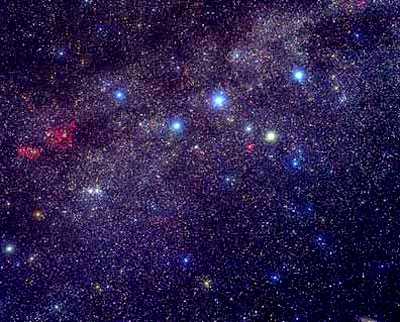
The constellation
Cassiopeia
This means that time is not some static line, like a film reel
playing itself out to its predetermined end.
Rather, at any given
moment, based on the collective choices of the units of
consciousness making up the whole, the future can go one way or
another. If people act in predictable, habitual ways and little
'new' choices enter the game, sure, the future can probably be
predicted.
But when an important choice affecting other future
choices is made, it's as if we have entered a new timeline, one that
previously existed only as a nebulous probability - one among
billions of such probabilities.
In this sense, we do exist on one 'line of time'. It's the reality
we experience as our lives: the events and interactions that make up
the sum total of our experience. But it's merely one of many
possible realities that we occupy based on our collective choices.
A
prediction that may have been true at one point in 'time', following
a choice that is significant to one degree or another on the part of
one or more individuals, may not hold true beyond that point. What
the Cs are basically saying is that predictions that turn out to be
wrong aren't necessarily wrong because the people were lying or
delusional (although many undoubtedly are).
Future events can be
foreseen, but there are certain laws and conditions that need to be
taken into account.
In volume five of her series, The Wave or Adventures with Cassiopaea,
Laura described it like this:
My guess is that the real world of third
density/dimensions, is a
collapsed wave function reality.
It is like the branch of a tree. At
certain nodal points, there are other branches that have the
possibility of "getting all the juice" and becoming the dominant
branch, and what determines which it is depends on many factors.
But, once one bud begins to dominate, the others become smaller and
smaller and fall away eventually for lack of "juice." There is only
one "real" reality. The others are only ghost or potential
realities. Like a tree, with gazillions of branches, each
individual's reality grows in this way. At certain points, there are
alternate realities.
But, depending upon choice, attention, and
other factors, those realities that are undesirable can be "pruned"
or deprived of sap so that they wither and fall away.
At the same time, each individual being their own "branch," has a
slightly different reality from every other individual, and some
responsibility for the way their branch grows. But it is all from
the same tree, and thus has a more or less single reality. If their
choices are "diseased," their branch will grow in a way that causes
it to be pruned, or wither, or face some interference even from
other branches, perhaps.
So, in a certain sense, at the nodal point, many possibilities may
exist, just as several buds may put out on the end of a branch, but
not all of them will continue the process of branching, and at such
points, we have some freedom to choose, individually or
collectively, depending on the nature of the branch.
Then there's this, from the Cs session on 26 November 1994:
Q: (T) One last question. How do I
know you are telling me the truth?
A: Open. For you to decide. Listen: Now would be a good "time"
for you folks to begin to reexamine some of the extremely
popular "Earth Changes" prophecies. Why, you ask. Because,
remember, you are third-density beings, so real prophecies are
being presented to you in terms you will understand, i.e.,
physical realm, i.e., Earth Changes. This "may" be symbolism.
Would most students of the subject understand if prophecies were
told directly in fourth-density terms?
Q: (L) Is this comparable to my idea about dream symbolism? For
example, the dream I had about the curling cloud, which I saw in
a distance and knew it was death-dealing and I interpreted it to
be a tornado, but it was, in fact, a dream of the Challenger
disaster. I understood it to be a tornado, but in fact, what I
saw was what I got: a death-dealing force in the sky, a vortex,
in the distance. I guess my dream was a fourth-density
representation but I tried to interpret it in terms I was
familiar with. Is this what you mean?
A: Close. But it is easy for most to get bogged down by
interpreting prophecies in literal terms.
Q: (L) In terms of these Earth Changes,
Edgar Cayce
is one of
the most famous prognosticators of recent note. A large number
of the prophecies he made seemingly were erroneous in terms of
their fulfillment. For example, he prophesied that Atlantis
would rise in 1969, but it did not, though certain structures
were discovered off the coast of Bimini, which are thought by
many to be
remnants of Atlantis. These did, apparently, emerge
from the sand at that time.
A: Example of one form of symbolism.

Q: (L) Well, in terms of this symbolism, could it be that [when
you tell us things about our reality], you read events
from
third-density into sixth-density terms and then transmit them
back into third; and while the ideation can be correct, the
exact specifics, in third-density terms, can be slightly askew
due to our perceptions? Is that what we are dealing with here?
A: 99.9 per cent would not understand that concept. Most are
always looking for literal translations of data. Analogy is:
novice, who attends art gallery, looks at abstract painting and
says, "I don't get it."
Q: (L) Well, let's not denigrate literal translations or at
least attempts to get things into literal terms. I like
realistic artwork. I am a realist in my art preferences. I want
trees to look like trees and people to have only two arms and
legs. Therefore, I also like some literalness in my
prognostications.
A: Some is okay, but, beware or else "California falls into the
ocean" will always be interpreted as California falling into the
ocean.
Q: (General uproar)
(F) Wait a minute, what was the question?
(L) I just said I liked literalness in my prophecies.
(F) Oh, I
know what they are saying. People believe that California is
just going to go splat! And that Phoenix is going to be on the
seacoast; never mind that it's at 1,800 feet elevation, it's
just going to drop down to sea level; or the sea level is going
to rise; but it's not going to affect Virginia Beach even though
that's at sea level! I mean ... somehow Phoenix is just going to
drop down and none of the buildings are going to be damaged,
even though its going to fall 1,800 feet ...
(T) Slowly. It's
going to settle!
(F) Slowly? It would have to be so slowly it's
unbelievable how slowly it would have to be!
(T) It's been
settling for the last five million years, we've got a ways to go
in the next year and a half!
(F) Right! That's my point!
(T) In
other words, when people like
Scallion and Sun Bear and others
who say California is going to fall into the ocean, they are not
saying that the whole state, right along the border is going to
fall into the ocean, they are using the term "California" to
indicate that the ocean ledge along the fault line has a
probability of breaking off and sinking on the water side,
because it is a major fracture. We understand that that is not
literal. Are you telling us that there is more involved here as
far as the way we are hearing what these predictions say?
A: Yes.
Q: (T) So, when we talk about California falling into the ocean,
we are not talking about the whole state literally falling into
the ocean?
A: In any case, even if it does, how long will it take to do
this?
Q: (LM) It could take three minutes or three hundred years.
(T)
Yes. That is "open" as you would say.
A: Yes. But most of your prophets think it is not open.
Q: (T) Okay. So they are thinking in the terms that one minute
California will be there and a minute and a half later it will
be all gone. Is this what you are saying?
A: Or similar.
Q: (T) So, when we are talking: "California will fall into the
ocean," which is just the analogy we are using, we are talking
about the possibility that several seismic events along the
fault line, which no one really knows the extent of ...
A: Or it all may be symbolic of something else.
Q: (L) Such as? Symbolic of what?
A: Up to you to examine and learn.
Q: (L) Now, wait a minute here! That's like sending us out to
translate a book in Latin without even giving us a Latin
dictionary.
A: No it is not. We asked you to consider a reexamination.
Q: (L) You have told us that there is a cluster of comets
connected in some interactive way with our solar system, and
that this cluster of comets comes into the plane of the ecliptic
every 3,600 years. Is this correct?
A: Yes. But, this time it is riding realm border wave to 4th
level, where all realities are different.
Q: (L) Okay, so the cluster of comets is riding the realm border
wave. Does this mean that when it comes into the solar system,
that its effect on the solar system, or the planets within the
solar system,
(J) or us
(L) may or may not be mitigated [made
less severe] by the fact of this transition? Is this a
mitigating factor?
A: Will be mitigated.
Q: (L) Does this mean that all of this running around and
hopping and jumping to go here and go there and do this and do
that is ...
A: That is strictly 3rd-level thinking.
Q: (L) Now, if that is third level thinking, and if a lot of
these things are symbolic, I am assuming they are symbolic of
movement or changes in energy.
A: Yes.
Q: (L) And, if these changes in energy occur, does this mean
that the population of the planet are, perhaps - in groups or
special masses of groups - are they defined as the energies that
are changing in these descriptions of events and happenings of
great cataclysm? Is it like a cataclysm of the soul on an
individual and or collective basis?
A: Close.
Q: (L) When the energy changes to fourth density, and you have
already told us that people who are moving to fourth density
when the transition occurs, that they will move into fourth
density, go through some kind of rejuvenation process, grow new
teeth, or whatever; what happens to those people who are not
moving to fourth density, and who are totally unaware of it? Are
they taken along on the Wave by, in other words, piggybacked by,
the ones who are aware and already changing in frequency, or are
they going to be somewhere else doing something else?
A: Step by step.
Q: (T) In other words, we are looking at the fact that what's
coming this time is
a Wave that's going to allow the human race
to move to fourth density?
A: And the planet and your entire sector of space-time.

The Wave by *LaPurr
Q: (T) Is that what this whole plan is about, then, if I may be
so bold as to include all of us here in this? We could be beings
who have come here into human form, to anchor the frequency. Is
this what we are anchoring it for, for this Wave; so that when
it comes, enough of us will be ready, the frequency will be set,
so that the change in the planet can take place as it has been
planned?
A: Yes.
Q: (T) Okay, when the people are talking about the Earth
Changes, when they talk in literal terms about the survivors,
and those who are not going to survive, and the destruction and
so forth and so on, in third, fourth, and fifth-level reality,
we are not talking about the destruction of the planet on
fourth-level physical terms, or the loss of ninety per cent of
the population on the fourth level because they died, but
because they are going to move to fourth level?
A: Whoa! You are getting "warm".
Q: (T) Okay. So, we are anchoring this. So, when they talk about
ninety per cent of the population not surviving, it is not that
they are going to die, but that they are going to transform. We
are going to go up a level. This is what the whole light thing
is all about?
A: Or another possibility is that the physical cataclysms will
occur only for those "left behind" on the remaining
3rd-level-density Earth.
So, not only do we have to take into
account the source of the prediction (whether it be delusion,
genuine 'psychic' ability, or communication with a 'higher'
intelligence) and the fact that prediction may be accurate at the
time but not after possible future events affecting its outcome, we
also have to consider that such things are often presented in
symbolic language.
And there may be something to the whole
'Rapture' concept after all, but as is usually the case, the truth
probably bears little resemblance to the religious gloss.
And, like
any avid reader of science fiction knows, one author's personal
'fantasy' may turn out to be strikingly close to reality, either now
or in the future.
Coincidence, or something else entirely?
Razing Arizona
With all that in mind, let's take a look at a series of predictions
given at one of the earliest sessions, 16 July 1994, on the day that
Comet Shoemaker-Levy 9's fragments collided with Jupiter in a
spectacular display that stunned scientists and observers the world
over.
Q: (L) What are you here for
tonight?
A: Prophecy.
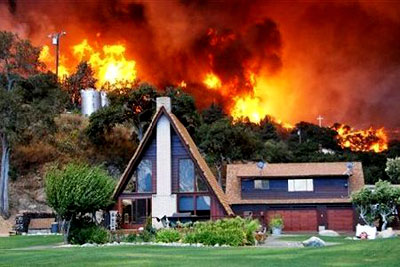
The Wallow Fires
in Arizona this year
Q: (L) What prophecies?
A: Tornadoes Florida - several.
Q: Where else?
A: Also Texas and Alabama.
Q: (L) When?
A: Sun is in Libra. {...}
Q: (L) What else is going to happen?
A: Seattle buried; Japan buckles; Missouri shakes; California
crumbles; Arizona burns.
First of all, there is a possible time
reference: "Sun is in Libra."
On the surface, this could be seen to
mean that these events are predicted to occur when the Sun is
visible on the backdrop of the constellation of Libra, which is 31
October to 22 November (or 24 September to October 23 in
astrological terms). Since this is near the end of hurricane season,
perhaps this is a prediction of a time of intense cyclonic storms?
However, keeping in mind the discussion of symbolism above, it could
also relate to the Sun being 'on the scales' or in 'balance',
perhaps with the brown dwarf that is hypothesized to be our Sun's
companion (stay tuned for that installment!).
On 11 July 1998, the Cs said:
Q: (A) I want to continue questions
from the previous session. First, about this companion star:
where is it now, which part of the zodiac?
A: Libra Constellation.
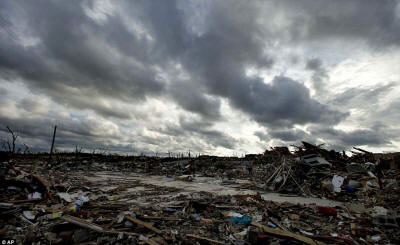
Part of the town of Joplin, Missouri
was
obliterated this year in the most devastating tornado in US history
So this series of predictions seems to be tied to the Sun's
hypothesized companion star and they were possibly given as
indicators of its approach.
Interestingly, 2011 saw several of these
events come to pass. While Texas saw some minor tornado activity on
24 October 2010, as did Florida on 31 March 2011, the Southern U.S.
(including Florida, Texas and Alabama, in addition to several other
states) was pummeled in late April 2011 in what was called "one of
the largest tornado outbreaks in history":
a series of
over 300
tornadoes, 15 of which were classified as EF4 or EF5 on the Enhanced
Fujita Scale, killing over 300 people (EF5 being the highest on the
scale).
Alabama was hit hardest, with 254 fatalities.
This was
followed the month after with a series of 158 tornadoes afflicting
the Midwestern U.S. and resulting in almost the same number of
fatalities. The major, multi-vortex EF5 tornado, which leveled the
town of Joplin, Missouri, stood out as
one of the major U.S. natural
disasters of recent years. All in all, after only five months, 2011
was deemed the deadliest year for tornadoes in recorded history.
Then, in late May/June, Arizona burned when the Wallow Fire consumed
over 500,000 acres in Eastern Arizona, making it the largest forest
fire in Arizona's history.
By the time the fire made the record
books, over 10,000 people had been displaced and the fire was only
six percent contained, with full containment "nowhere in sight." (A
possible meteor sighting occurred on 31 May, perhaps explaining how
this gigantic blaze erupted, although officials suspect a campfire
was to blame.)
And while the fires were just getting started,
Missouri shook with a
4.2 magnitude earthquake on 7 June.
Big One in
Japan
And of course,
Japan 'buckled' on 11 March 2011 when a magnitude 9.0
earthquake (upgraded from an original estimate of 8.9) killed just
under 16,000 people. It was one of the five largest earthquakes in
seismic record-keeping history, causing 10-metre-high tsunami waves
and resulting in the total meltdown of three nuclear reactors at
Fukushima.
This quake seems to have been predicted
by the Cs in another session as well, and in more detail.
Here's
what the Cs had to say on 5 October 1994:
Q: (L) We would also like to have
more information on Earth Changes. Is the Japanese earthquake
that just happened as you predicted last week, the last of the
Japanese problem? {An entire session had been lost due to tape
malfunction. It consisted in part of a prediction of an almost
immediate Japanese earthquake, which did occur exactly as
predicted.}
A: No.
Q: (L) Can you give us more on that?
A: There will be activity about 8.9: 67 miles off Osaka coast;
9.7: central Tokyo.
Q: (L) Are all of these going to happen within this year?
A: No. Within 16 years.
The Japanese quake occurred 16 years and
5 months after this prediction, although its location was not 67
miles off the coast of Osaka.
However, in 1994, and up until the quake
in 2011, a magnitude of 8.9 or 9.0 was unprecedented for Japan.
The
Cs expanded on their predictions for Japan on 21 January 1995:
Q: (T) So this [Japanese earthquake
on 17 January 1995] was not the quake that you predicted - the
8.9 - this was a 7.2, but it was miles distance from Osaka
almost right on the money, but this was not the quake that you
predicted?
(J) There's going to be another one coming?
A: Yes 14 more this sequence. {...}
Q: (T) This is one in a sequence of earthquakes that are going
to culminate in the 8.9?
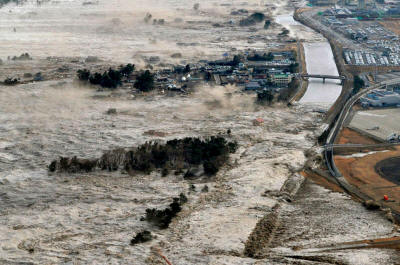
A whole swathe of
Japan
was wiped off the map this year too.
A: 9 pt 6.
Q: (T) In Osaka, near Osaka?
A: Tokyo.
Q: Okay, that's the one you talked about, then a 9.6, that's
going to be the culmination of the quakes in this [sequence].
This is only the third or fourth in a sequential series and the
8.9 that's going to hit them hasn't happened yet.
A: 7th.
Q: (T) This is the seventh earthquake?
A: Yes.
Q: (T) 7.2 was the seventh earthquake, there's going to be
fourteen of them, is that what you said before?
A: Yes.
Q: (J) So there's seven more coming? (T) So the fourteenth one
will be the big one, in Tokyo?
A: 13th.
Q: (T) Okay, the thirteenth is going to be the 9.6 and I think
the other prediction was 9.8, they're close. That'll be the
thirteenth. What will be the 8.9, which one of those will be the
Osaka 8.9?
A: Within next 4 [in the sequence?].
Q: (T) What will the fourteenth be?
A: Small.
If we only consider the quakes that
caused a significant number of deaths (>1) since that time, and if
the quake referred to above was the seventh in a series of fourteen,
then there is
a perfect match with the prediction so far:
-
17 January 1995 (6.8 - 6,434
deaths)
-
23 October 2004 (6.9 - 40 deaths)
-
16 July 2007 (6.6 - 11 deaths)
-
14 June 2008 (6.9 - 12 deaths)
-
11 March 2011 (9.0 - 15,826
deaths)
-
?
-
predicted 9.6 in central Tokyo
-
? (small)
Additionally, the physical stress of the
actual earthquake was not the only thing to 'buckle' Japan. The
Fukushima meltdowns and subsequent fallout continue to threaten the
health of the region's inhabitants, and residents are confused and
furious.
Another possible hit occurred
in April 2011 when an 8.2-lb gold
nugget was discovered in California, prompting some to predict a new
Gold Rush in the region.
On 3 December 1994, the Cs had included
this nugget in a string of predictions and markers of future events:
A: Gold is discovered in California after one of the quakes.
Of course, this doesn't necessarily need to refer to a California
quake, and the fact that it was discovered in the aftermath of the
Japanese quake is suggestive.
But speaking of California, possibly
in reference to "California crumbles" in the 1994 session, the Cs
also had this to say in the 21 January 1995 session about a possible
catastrophic quake in California:
Q: (T) OK, so when this all happens
is there going to be an effect on California of all of this, on
the West Coast of this country?
A: Yes.
Q: (T) Not just California. Is Los Angeles going to be hit with
any of these big earthquakes as the plate on the other side
moves?
A: Yes.
Q: (T) What magnitude?
A: 8.9
Q: (T) Where will that happen?
A: San Gabriel Mountains.
Q: (T) Is that outside of Los Angeles? San Andreas Fault line?
A: Yes.
Q: (T) Will this be very destructive to Los Angeles?
A: What do you think?
Q: (T) In the destruction of this area, is this going to
increase the job potential on the East Coast, in order to then,
this is really serious stuff here, because this is going to
affect the economy the way it shifts...
A: Yes.
Q: (T) So it...
A: Mass exodus from California. {The Cs had also said this on 3
December 1994: "Expect gradual destruction of California economy
as people begin mass exodus."}
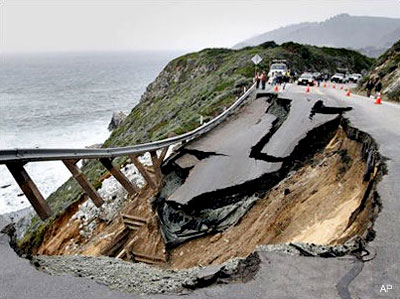
© AP Photo/Monterey Herald, Orville Myers
A section of the southbound lane of Highway 1
slides down the
hillside on Wednesday,
16 March 2011 in Big Sur, California
Q: (T) Those dumb people out there looked at that Osaka stuff
and said, "Oh, you know, that might happen to us." OH, boy, the
brain finally fired up out there. (J) They've been in denial
about that out there...
(D) Will that bring an influx of people
to Florida?
A: Yes. 15 quakes.
Q: (D) And then they're going to move.
(T) Fifteen quakes in the
California area?
A: In near future.
Q: (T) Are we talking strictly the West Coast here?
A: California.
Q: (T) Are there going to be earthquakes elsewhere in the United
States?
A: Yes.
Q: (T) Fifteen in the near future in California alone...
(D)
This is the beginning of the destruction of the state of
California, there'll be separation from the North American
continent.
(T) Well, they said don't take that literally, or it
will fall off, it's symbolic...
A: Open.
Q: (T) So look at it symbolically.
(D) Okay.
(J) Where are the
other quakes going to be?
A: Hundreds [in addition to those in California].
Given the Cs' use of symbolic language
as well as their comments on a 'mass exodus', perhaps the
'California crumbles' remark is referring to the general state of
California's economy.
As the Business Insider
reported in October
2010,
"the economy of the state [of California] is in shambles."
Unemployment had risen from around 5% in 2006 and 2007 to over 12%.
Poverty rates are the highest in over a decade, the health care
system is about to collapse, and five out of six businesses are out
of business.
While
there are fewer Californians leaving the state
than in past recessions (500,000 between 2004 and 2010 compared to
1,500,000 between 1991 and 1998), California's domestic immigration
is still in the negative. And the record number of businesses
relocating out of state in 2010, which has only accelerated in 2011,
has been called an 'exodus' in the media, with headlines like 'CA
Business Exodus Accelerates' and 'The California Exodus'.
204
companies left in 2010, making for an average of 3.9 per week. By 16
June 2011, that average was already at 5.4 per week.
Given the timing of the events in question, perhaps
this little news
item is symbolic in and of itself?
It is the most scenic highway in America, but a big chunk of
California's Highway 1 has fallen into the sea after a landslide.
Stunned drivers watched as a forty-foot section tumbled into the
Pacific below after several days of rain.
The landslide, at 5pm on
Wednesday [16 March 2011], happened 12 miles from Carmel. A two-mile
stretch is now closed for repairs which are expected to take several
days.
A sign of things to come? Needless to say, the Cs repeatedly
stressed that the near future would be a time of extreme weather and
Earth Changes, which is now playing itself out with frightening
accuracy.
After the extremes of 2010, 2011 has only upped the ante
in turns of natural disasters.
With record numbers and intensity of
floods, cyclonic storms, snowfall, meteor sightings and sun-grazing
comets, it looks like Mother Nature is just getting warmed up.

Riding the Wave
Part 2
Space and Weather Science Gone Wild
07 November 2011
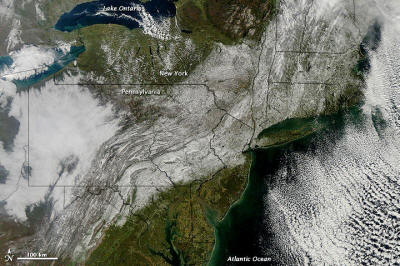
© MODIS - NASA
Terra satellite
Millions of people were left without power
as a snowstorm
dropped as much as 32 inches (81 centimeters)
on some parts of the
northeastern United States in late October 2011.
We started this series with a pretty 'out-there' topic: prophecy.
But the Cassiopaean Experiment, while
pretty 'out-there' to begin with (at least from the mainstream
perspective), also deals with more 'down-to-earth' subject matter.
Issues relating to more conventionally understood and practiced
science (albeit with often unconventional interpretations) make up a
large portion of the received data.
It's been my experience that people tend to forget that scientists
are 'human' too, or more precisely, scientists can be just as
willfully blind, self-serving, conformist, fearful and mendacious as
anyone else.
Some of them are even unabashed con men who falsify
their data, or intellectual prostitutes who will produce the results
they are paid to, whether they believe them or not. Just because
it's been peer-reviewed, or written by a person with a string of
letters after their name, doesn't mean it's true, or even remotely
so. And if history tells us anything, it's that the history of
science is a long history of wrong or incomplete ideas.
So it's best
to be skeptical whenever scientists speak in terms of absolutes with
certainty, whenever they put the lid on testing alternate
hypotheses. Chances are, they're simply deceiving themselves, and
you.
Science is a work in progress.
The theories that are taken for
granted as being true may very well turn out to be completely bogus
following the intervention of new discoveries and innovations.
Sadly, space and weather science are two areas where innovation not
only rarely occurs, it is actively hindered by scientists and
politicians with vested interests in keeping old, inadequate
theories at the forefront of popular and academic belief systems.
Like many of the examples that will follow in subsequent
installments of this series, the ones below are just a sample of
ideas that at first glance may look just plain wrong.
But new
discoveries have been proving many outdated preconceptions to be
just that.
Hide the
Decline, CYA
One of the biggest myths of recent years in weather science is that
of 'global warming', specifically anthropogenic (manmade) global
warming.
What this means is that a certain cause (or 'forcing')
leads to a change in global temperature, causing positive feedback
to make it get even hotter. The idea is that as manmade carbon
dioxide (a so-called 'greenhouse gas') emissions have increased over
the last hundred or so years, so has the temperature of the earth's
oceans and atmosphere.
The observed correlation is taken as
causation, and thanks to
the propagandizing efforts of people like
Al Gore, the idea has taken hold, despite the fact that
the whole
façade is built on bad science.
Here's what the Cs had to say in April
2007:
Q: What percentage of what we're
seeing today as global warming is coming from manmade compared
to cosmic [causes]?
A: 4 percent.
Q: (J) There ya go. So let's buy a Hummer. [laughter] (H) And
are the people that are selling us the global warming ... are
they aware that this is all ... all fake?
A: Some.
In September 2008, Dr. Zbigniew
Jaworowski published an op-ed piece for The New Zealand Centre for
Political Research, 'Sun Warms and Cools the Earth', in which he
quoted Tom Segalstad, author of a review of carbon cycle research.
Here's what Jaworowski wrote:
To fit these data into a global carbon cycle, IPCC assumed a
speculative lifetime for man-made CO2 in the atmosphere as 50 to 200
years, ignoring observational evidence from 37 studies (based on
natural and nuclear bomb carbon-14, Suess effect, radon-222,
solubility data and carbon-13/carbon-12 mass balance) documenting
that the real lifetime is about 5 years.
With CO2 atmospheric
lifetime of about 5 years, the maximum amount of man-made CO2
remaining now in the atmosphere is only 4%, and not 36% (see review
in (Segalstad, 1998)).
Here's Segalstad
in his own words:
Water vapor is the most important "greenhouse gas". Man's
contribution to atmospheric CO2 from the burning of fossil fuels is
small, maximum 4% found by carbon isotope mass balance calculations.
The "Greenhouse Effect" of this contribution is small and well
within natural climatic variability. The amount of fossil fuel
carbon is minute compared to the total amount of carbon in the
atmosphere, hydrosphere, and lithosphere. The atmospheric CO2
lifetime is about 5 years. The ocean will be able to absorb the
larger part of the CO2 that Man can produce through burning of
fossil fuels.
The IPCC CO2 global warming model is not supported by
the scientific data. Based on geochemical knowledge there should be
no reason to fear a climatic catastrophe because of Man's release of
the life-governing CO2 gas.
The global climate is primarily governed
by the enormous heat energy stored in the oceans and the latent heat
of melting of the ice caps, not by the small amount of heat that can
be absorbed in atmospheric CO2; hence legislation of "CO2 taxes" to
be paid by the public cannot influence the sea level and the global
climate.
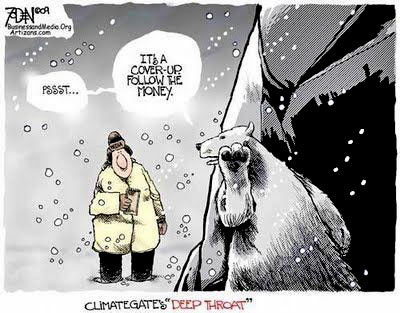
© Artizons.com
What the promoters of manmade global warming ignore is the fact that
the correlation between CO2 levels and global warming is just that:
a correlation.
But CO2 levels have been on the rise for tens of
thousands of years, long before humans started releasing 'greenhouse
gases' as a result of industrialization. In fact, there is an
observable 'lag' in the data. CO2 levels follow temperature
variations by around 800 years, not the opposite.
The implication is
obvious: global warming is a natural phenomenon of climate
variation, probably driven by some other factor, perhaps varying
solar activity. And CO2 levels may well be a result of the true
cause of global warming, not the cause.
But overestimating the effect of manmade CO2 is not the only problem
presented by the data. Has the earth even been warming at all in
recent decades? Despite the repeated news headlines of 'warmest
day/year on record', the answer is no, not really.
First of all,
many weather-reporting stations that are used to come up with global
averages are placed
near heat-generating sources, causing them to
give results that do not reflect actual temperatures. As cities
develop, more heat-generating sources are produced, resulting in
higher temperature readings at these sites. But these readings of
local variations do not reflect the global climate.
As meteorologist
Roy Spencer writes in his book
The Great Global Warming Blunder
(2010),
"One recent estimate is that as much as 50
percent of the warming measured over land in the last thirty years
could be spurious, due to various indirect effects of economic
growth contaminating the thermometer data."
(p. 12-13)
Then there's the fact that the more precise orbiting satellite data
(measured since 1979, and only since around 2000 has NASA's Aqua
satellite been calibrated to account for periodic changes in
observation time) has shown no significant warming
for the last 18
years.
Dr. Spencer writes that there has been no cooling since 2001,
after the "particularly warm El Niño year" of 1998 (p. 6). More
precisely, they have shown normal fluctuations of heating and
cooling.
As Spencer writes,
"While we can probably say with high
confidence that the climate has warmed in the last 50 to 100 years,
it is more difficult to say by exactly how much, still more
difficult to say whether it is unprecedented or not, and impossible
to say what any of this means for future temperatures."
(pp. 13-14)
And, of course, November 2009's 'Climategate' controversy showed
just how far some scientists were willing to knowingly distort and
falsify data in order to fit their preconceived notions and keep
their research grants coming.
Internal emails from scientists at the
University of East Anglia's Hadley Climate Research Unit revealed
that the 'scientists' had knowingly excluded data from reports and
graphs that would have shown an actual decline in global
temperatures and the observed warming trend in recent decades and
other periods of history, in order to give the false impression of
continuous warming where there was none.
By obscuring the historical
evidence of the Medieval Warm Period and the Little Ice Age, climate
scientists were able to give the impression that our current climate
fluctuations were not business as usual.
In fact, despite the
imprecision of all methods for indirectly measuring temperature in
the past (the only surefire way is direct temperature readings,
which are only available for the last 100 years or so), all the data
shows exactly that: natural fluctuations, periods of cold, periods
of warm, with quick up-swings and down-swings in between.
In other words, they cherry-picked their data, just like they
cherry-picked the reporting stations that gave them the data they
needed to fit the facts around their beliefs. The graph below shows
how the number of stations reporting average temperatures dropped
dramatically in 1990.
Coincidentally, this is when the graph shows a
remarkable increase in temperature. The connection is hard to miss.
For whatever reason (we can hazard a guess), the scientists
responsible for hyping global warming eliminated many stations
reporting lower temperatures in 1990. In all likelihood, if they had
continued to use that data, there would be no warming.
In fact,
there might even be
evidence of cooling.
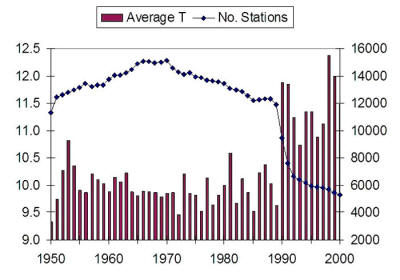
Origen
What everyone seems to be ignoring is the fact that this is a
natural cyclic phenomenon.
Earth temperatures do rise. But they
don't just keep going, like a house with a broken thermostat. They're always followed by cooling.
In other words:
Ice Age.
Ice Age II
Here's what the Cs had to say about ice ages on 22 February 1997:
A: [R]emember this: a change in the
speed of the [earth's] rotation may not be reported while it is
imperceptible except by instrumentation. Equator is slightly
"wider" than the polar zones. But, this discrepancy is
decreasing slowly currently. One change to occur in 21st Century
is sudden glacial rebound, over Eurasia first, then North
America. Ice ages develop much, much, much faster than thought.
Then there's this from 18 March 2000:
Q: You also made a remark once that
ice ages occur much, much faster than people ever thought...
A: Yes. {...} and faster when in response to global "warming."
Q: When you put "warming" in quotes, you obviously mean warming
in more than just an ordinary sense? Is that correct?
A: And/or not really "warm."
And this, from 9 May 1998:
Q: Why was the sea level several hundred feet lower [in the
past]? Because there was ice somewhere or because there was not
as much water on the earth at that time?
A: Ice.
Q: Was the ice piled up at the poles? The ice sheet of the ice
age?
A: Yes.
Q: So, Atlantis existed during the ice age? [Atlantis being a
designation for an alleged technologically advanced society
living during Paleolithic times.]
A: Largely, yes. And the world's climate was scarcely any colder
away from the ice sheets than it is today.
Q: Well, how could that be? What caused these glaciers?
A: Global warming.
Q: How does global warming cause glaciers?
A: Increases precipitation dramatically. Then moves the belt of
great precipitation much farther north. This causes rapid
buildup of ice sheets, followed by increasingly rapid and
intense glacial rebound.
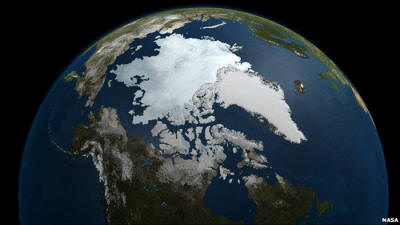
Recent years have seen exactly that,
despite claims of continued
'global warming'.
The ozone hole is cooling the Antarctic's
stratosphere, causing increased precipitation in the subtropics and
moving the westerly jet stream closer to the south,
pulling storm
tracks with it.
Glaciers are growing on California's Mt. Shasta,
Italy's Mount Canin and Mount Montasio, in India, Antarctica,
Greenland, the Arctic, New Zealand, Argentina, Alaska, the
Himalayas, Bolivia, and elsewhere.
In 2006, the BBC
reported that,
"Global warming could be causing some glaciers to grow, a new study
claims. Researchers at Newcastle University looked at temperature
trends in the western Himalaya over the past century. They found
warmer winters and cooler summers, combined with more snow and
rainfall, could be causing some mountain glaciers to increase in
size."
In other words, the water cycle rebounds between periods of
extended heating/evaporation and melting of ice caps, and then mass
precipitation and buildup of ice at the poles, like a great global
thermostat that resets when certain upper and lower limits are
reached.
(After all, the polar regions are consistently too cold for
anything but snow to fall, so increased precipitation would lead to
a buildup of ice and snow, not the opposite - Spencer, p. 62)
What the Cs are describing is essentially a negative feedback
system.
Rather than out-of-control warming, the earth's climate
system has in-built mechanisms to bring rising and falling
temperatures back into equilibrium. Of course, this flies in the
face of global warming propaganda, but anyone looking honestly at
the data can see that this is exactly how our climate has operated.
Consider also the record low atmospheric temperatures, rising ocean
temperatures (probably caused by
underwater volcanism) leading to
massive evaporation and precipitation as evidenced in the number of
extreme floods and record-breaking snowfalls in recent years, and
the fact that the last ice age ended about 11,500 years ago.
In the
1970s, CLIMAP (Climate: Long-range Investigation Mapping and
Prediction)
discovered an ice age cycle of 11,500 years. In other
words, we're right on time for another. In fact, we're overdue. And
when the next ice age comes, it's
going to come fast, just as the Cs
proposed:
According to ice core researcher Jørgen Peder Steffensen:
"Our new,
extremely detailed data from the examination of the ice cores shows
that in the transition from the ice age to our current warm,
interglacial period, the climate shift is so sudden that it is as if
a button was pressed."
This discovery suggests that our current
climate could undergo a similar rapid change, shifting back into ice
age mode in just one year.
But would the earth experience a 'runaway cooling' akin to that
which those who picture an ever-heating earth because of 'global
warming' imagine? Not likely. Global warming is founded on the basis
of multiple successive positive feedback mechanisms (i.e.
temperatures rise and rise without any negative feedback to bring
them back down).
If the earth climate system in fact contains
built-in negative feedback mechanisms (as Spencer argues in his
book), the same isn't true.
Instead of doubling upon doubling,
"it's
like halving a number, then halving it again, and then again. You
slowly approach zero, but never quite reach it. As a result, there
can be no climate catastrophe with net strongly negative feedbacks -
only with net strongly positive feedbacks."
(Spencer, p. 63)
In
other words, yes, we have ice ages, but climate (or the total heat
content of the earth), as always, fluctuates between its naturally
defined upper and lower limits. What we do not know are the exact
mechanisms by which this happens.
As for the idea that underwater volcanism contributes to the water
cycle of ice ages, the Cs said the following on 18 February 1995:
A: {...} Volcanic eruption under
arctic ice in 1996.
Q: (T) Cool!
(L) That ought to be a real zinger.
(T) That will
bring us some floods then!
A: No. Weather causing increased evaporation ...
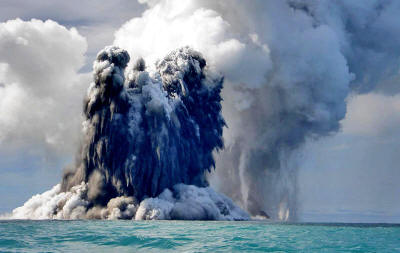
An undersea volcano erupts near the Pacific island of Tongatapu in
2009.
Approximately 90% of the world's millions of volcanoes lie
under the oceans.
According to Dr. Spencer, quoted above,
"it has recently been
demonstrated that if the oceans warm for any reason, global land
areas can warm even more. This makes the oceans a potential key
player in long-term climate change."
(pp. 11-12)
Increased volcanism
is just one possible example of 'forcing', leading to a change in
temperature.
If we want to know what happens after that, we need to
know what kind of feedback mechanisms are involved. If cloud cover
is one such mechanism, as Spencer argues, the scenario could look
something like this: Warmer oceans and land temperatures lead to
increased evaporation, thus increased water vapor, cloud cover and
precipitation.
And more low-lying cloud cover means more negative
feedback (cooling) because of the increased reflection of solar
radiation. And, of course, increased precipitation over the poles
could plunge earth into another ice age in its efforts to
re-balance.
In 2006 it was reported that German-American researchers,
"discovered
more hydrothermal activity at the Gakkel Ridge in the Arctic Ocean
than anyone ever imagined."
Expecting a 'hydrothermally dead ridge',
the researchers were surprised to discover
high levels of volcanic
activity in this Arctic region.
Then, in 2008 geophysicist Robert Sohn
discovered volcanic explosions,
"at depths previously thought
impossible."
He even said,
"This kind of implosive seismicity is
rare anywhere on Earth."
At the times that all of this data was
received from the Cs, many would have found it unlikely and even
outlandish, but science is proving them correct on many points.
We
wonder what other discoveries lie just around the corner?
Global Warming
Spin, Rinse and Cycle
But what exactly are the root causes of the climate changes earth
has been experiencing? The Cs have also identified possible
contributing factors.
From 23 July 1994:
Q: (L) What is causing the earth
changes?
A: Electromagnetic wave changes.
Q: (L) Can you be more specific?
A: Gap in surge heliographic field.
On 22 February 1997, they also had this to say:
Q: (L) Is the weather being controlled or changed or in any way
affected by
HAARP?
A: Climate is being influenced by three factors, and soon a
fourth.
Q: (L) All right, I'll take the bait; give me the three factors,
and also the fourth!
A: 1) Wave approach.
2) Chloroflorocarbon increase in
atmosphere, thus affecting ozone layer.
3)
Change in the
planet's axis rotation orientation.
4) Artificial tampering by
3rd and 4th density STS forces in a number of different ways.
...
Q: (L) All right, were those given in the order in which they
are occurring, the fourth being the one that's coming later?
A: Maybe, but remember this: a change in the speed of the
rotation may not be reported while it is imperceptible except by
instrumentation. Equator is slightly "wider" than the polar
zones. But, this discrepancy is decreasing slowly currently.
{...}
Q: (T) Is the Earth expanding? That's just putting it bluntly,
but, is the Earth expanding, how did you put that?
(Ark) Yes,
that's the theory: the idea is that the continents move away
because the Earth is expanding, and this is much faster than you
know, than geologists were thinking.
A: Continental "drift" is caused by the continual, though
variable, propelling of gases from the interior to the surface,
mainly at points of magnetic significance.
Q: (J) What causes the change in the axis?
A: By slowdown of rotation. Earth alternately heats up and cools
down in interior.
Q: (L) Why does it do that? What's the cause of this?
A: Part of cycle related to energy exerted upon surface by the
frequency resonance vibrational profile of humans and others.
Of the four causes listed above, numbers
2 and 3 (as well as the reference to the "surge heliographic field"
in the previous session) most readily offer themselves up for some
sort of scientific verification.
The chlorofluorocarbon effect on
the ozone layer has been recognized at least
since the 1970s.
But as
far as I can tell, the influence of changes in the rotation of the
earth on climate hasn't received nearly as much scientific
investigation. Recently, however, the subject made the news,
suggesting one possible way in which it may have such an influence.
In August 2010, Physics Central published an interesting piece about
new research suggesting a link between the Sun's output, cosmic
rays, earth's rotation and weather:
One of the team members, Vincent Courtillot of the Institute of
Geophysics of Paris, says they examined the length of day - as
defined by the speed of the earth's rotation in a reference frame
fixed with respect to the stars - using a series of daily values
over a 40-year period. They claim that up to 30 percent of changes
could be directly related to the 11-year sunspot cycle.
Of course, 30 percent of that change only amounts to a few tenths of
a millisecond, so you'd never actually notice it, but what's more
compelling (read 'very highly controversial') is the potential for
cosmic rays to have such a profound effect.
Courtillot and his colleagues have been among those championing a
radical theory that cosmic rays can impact the formation of clouds
and in turn, play a major part in climate changes.
But how could
cosmic rays possibly change the speed of our planet's rotation?
Here's how Courtillot explained it to me in an email:
"The causal chain is the following: the changes in Earth rotation
are simply reflecting the changes in angular momentum of the Earth's
atmosphere, more precisely the integral of zonal winds. And it has
been suggested that cosmic rays influence cloud condensation nuclei
formation.
If you change the cloud cover by say 10-percent, you
change the amount of energy reflected by cloud tops by 8 Watts per
square meter, which is very significant in the Earth's radiative
budget.
So this is the suggested link: cosmic rays affect cloud
cover, which affects the atmosphere's energy budget, which may alter
the wind speeds and organization, which changes the Earth's angular
momentum hence (length of day)."
It may sound like a reach (and relationships don't prove causation),
but other physicists have claimed that the sun's magnetic field
could potentially beat back cosmic rays and slow the rate at which
they reach Earth.
So when solar activity decreases there's less to
deflect the cosmic rays and they can again reach Earth in greater
numbers, potentially leading to a substantial enough change in winds
to effect Earth's angular momentum.
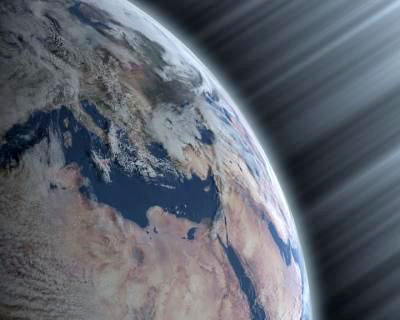
In other words, changing weather patterns may be (at least in part)
a result of cosmic ray-seeded clouds, which cause a need to conserve
angular momentum, thus leading to an almost imperceptible slowing of
the earth's rotation.
And according to Dr. Spencer, cloud cover is
perhaps the main driver in climate fluctuation within the earth
system. But while suggestive of some possible causative mechanisms,
the cosmic-ray theory of climate change is based more on speculation
than observable evidence.
What is most interesting is the idea of
possible factors affecting earth's angular momentum and the effects
they might have on earth processes affecting climate, as well as the
role of the Sun in all of these phenomena.
In fact,
the Sun appears
to be the prime mover of global weather and climate.
Note the last sentence in the above quotation. The author is
essentially describing a 'gap' in the Sun's 'surge' of charged
particles sent out through the solar system. (In the 1994 Cs
session, 'heliographic field' could essentially mean the Sun's
measurable field of electromagnetism.)
But the mechanisms for how
this actually affects earth weather are best found elsewhere.
According to Piers Corbyn, meteorologist, astrophysicist and head of
WeatherAction.com, who has made a name for himself with his
revolutionary and highly accurate techniques predicting weather
patterns based on solar activity, cosmic rays actually
play a
miniscule role.
Corbyn's method involves observing how charged
particles interact with earth's upper atmosphere and the jet stream,
and the moon's influence on these particles, matching these
observations with historical records to discern patterns.
According
to Corbyn:
The latest advances in Sun-Earth relations show not only the primacy
of magnetic-particle links between the sun and the earth but that
these are modulated by lunar effects to give the observed 60 year
cycle in both world and USA temperatures.
This means that the world
will continue general cooling at least to 2030. Neither the 60 year
cycle, nor the 22 year cycle nor any fluctuations in world
temperatures over the last 100 years, thousand years or million
years can be explained by changes in CO2. [If cosmic rays were the
main driver, the cycle would follow the 11-year solar cycle, since
cosmic rays follow the Sun's cycle.]
Furthermore, advances in
understanding of Sun-Earth magnetic and particle activity are being
applied to successfully predict dangerous weather and climate change
events months and years ahead; whereas all predictions of the
CO2-centred theory have failed and will continue to fail, and
anti-CO2 taxes and measures will never stop a single extreme weather
event.
The UN's Climate Change committee (the IPCC) have still
failed to respond to requests from an international group of
scientists to provide data evidence for the CO2 theory.
Dr. Roy Spencer has also identified a 60-year cycle called the
'Pacific Decadal Oscillation', a fluctuation between 30-year
'positive' and 'negative' phases based on,
"two different average
circulation states that the ocean-atmosphere system seems to have a
difficult time choosing between."
(If
James McCanney
is correct
about the Sun-Earth connection and its influence on the jet streams
and atmospheric phenomena, the PDO could conceivably be an effect
driven by solar influences.)
Spencer, too, is critical of the
consensus view that CO2 drives global warming, seeing instead cycles
within cycles based on changing cloud cover.
Based on observations
of these cycles,
he writes,
"And now, as of late 2008, it looks like
we might have entered into a new, negative (cooling) phase of the PDO. Only time will tell whether this pattern persists."
See his
graph of global temperatures, culled from NOAA satellite data,
here.
Notice the sinusoidal pattern of the graph, indicating that earth is
currently swinging into a 30-year trend of cooling.
Incidentally,
The last time the PDO changed phase was in 1977, an event that some
have called the "great Climate Shift of 1977." This event brought an
end to the slight global cooling trend that started in the 1940s... which was then replaced with a warming trend from the late
1970s through the 1990s.
After the Great Climate Shift, Alaska warmed immediately and then
remained warm. Temperatures in the Arctic started rising ... Arctic
sea ice cover was observed to start shrinking in the 1980s by our
new satellite measurements...
Contrary to what you may have heard
in news reports, the recent warming in the Arctic is probably not
unprecedented. It was just as warm in the late 1930s and early 1940s
when the PDO was also in its positive, warm phase...
Most of the
all-time high temperature records in the United States were set in
the 1930s.
(Spencer, p. 19)
Of course, there is a whole lot more to
these issues than the information presented above.
After researching all these
related subjects over the years, a picture is starting to emerge.
The Earth Changes we are experiencing
are a natural phenomenon, and human activity has little to nothing
to do with them (at least not in the ways popularly imagined).
Something strange, but not unprecedented, is
happening throughout
our solar system.
It has to do with cosmic influences and
their effects on and through our Sun and, as a result, our weather.
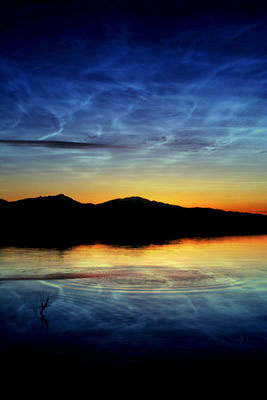
Part 3
History Is Bunk
25 November 2011
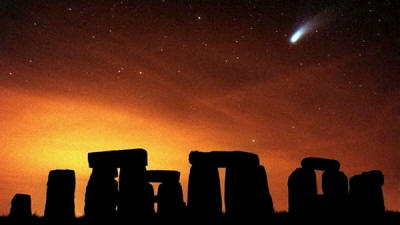
Hale-Bopp over
Stonehenge
Update:
We covered a list of prophecies in
the first part of this
series.
The idea of California 'falling into the
sea' was mentioned. Just a few days ago, another chunk of it
did
just that. Specifically, part of the Paseo del Mar road in San Pedro
fell into the Pacific Ocean after a landslide
on 21 November.
We
don't think this particular landslide is what the Cs were referring
to, just thought the timing was interesting in light of bringing it
up here!
Just as new discoveries in science can overturn a previously held
'consensus' in a heartbeat (often to the consternation or willful
disbelief of those promoting the consensus), new historical data can
turn our ideas of what we think happened in our history on their
head.
We often take for granted that event X occurred in year Y,
forgetting that either or both of those variables may be completely
false. The event may turn out to have been a fiction, created by
scribes and leaders of the time (or years later) for purposes of
political propaganda.
Dating methods may be inaccurate or possess
possible confounding factors, mucking up the accepted timeline.
Or,
when new documents or scientific data are discovered, the event may
turn out to bear little resemblance to our previous ideas of how it
happened. New actors emerge with new motivations, necessitating a
revision of the history books and the way we see the events and
personages of our near and distant past.
Then there are the problems inherent in the study of prehistory,
before the advent of 'history' as we know it. There, we only have
scarce clues to rely on, all built on sciences which are themselves
built on certain assumptions about the way things work.
Archaeology, paleoanthropology, population and molecular genetics, climate
science, geology... all of these contribute to a story of the past
that historians create for us. When we consider the relatively young
age of many of these sciences, the amount of information that we
have amassed in that short amount of time is pretty staggering.
But
it's important to keep in mind that history too is a work in
progress; new theories and advancements in science can prompt a
radical revision of old ideas.
Prehistory occupies a good portion of the Cs transcripts. While
archaeologists and anthropologists can piece together broad outlines
of migrations, genetic mixing, human behaviors, population
bottlenecks, etc., this was a period from which no written records
appear to have survived. As such, it's hard to verify specific
historical details and much of what the Cs say about these times
remains interesting conjecture.
But while much of it is
unverifiable, it also provides opportunities to test the material as
new discoveries come to light: fossil finds, climate studies,
evidence for catastrophes and extinctions, and more.
The Caveman
Who Wasn't There
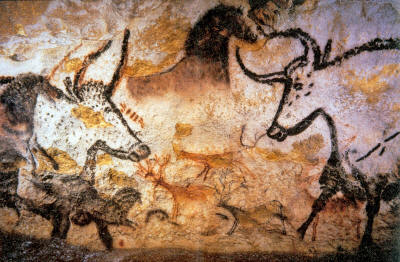
Cave paintings in
Lascaux,
southwestern France
On 15 April 2000, the following exchange
took place on early hominids:
Q: (L) Well, for a period of time it
seems that they [Neanderthals] continued to exist on the planet
alongside the new model, Cro-Magnon or whatever.
A: Some did.
Q: (L) For how long did Neanderthal exist side by side with the
'new model'?
A: 233 years.
Q: (L) I thought that Neanderthal was here for a long, long,
long time; and if modern man arrived on the planet, as you say,
seventy to eighty thousand years ago, wasn't Neanderthal already
here then?
A: Time references have been miscalculated.
For a long time, this remark seemed
somewhat unbelievable.
After all, according to the experts,
Neanderthals existed for almost 200,000 years, finally becoming
extinct around 27 to 28,000 years ago. For example, one of the
historically latest Neanderthal fossil finds, found in the Zafarraya
cave in southern Spain, has been dated to 30,000 years ago (Ian
Tattersall and Jeffrey Schwartz, Extinct Humans [New York:
Nevraumont, 2001], pp. 176, 219).
In contrast, the earliest
anatomically and behaviorally modern human remains have been radiometrically dated to about 35 to 40,000 years ago, making for an
overlap of several thousand years (Paul Mellars, The Neanderthal
Legacy [Princeton: Princeton University Press, 1996], pp. 2, 392).
This time period coincides with the so-called 'Paleolithic
Revolution', during which what we consider to be fully 'modern'
human behavior exploded onto the scene, as evidenced in the stunning
cave art of the Aurignacian period.
However, in May 2011, direct dating of an important Neanderthal
fossil threw a monkey wrench into this 'accepted' chronology.
Science News
reported that Dr. Ron Pinhasi and his colleagues,
"dated
a Neanderthal fossil discovered in a significant cave site in Russia
in the northern Caucasus, and found it to be 10,000 years older than
previous research had suggested."
The article continues:
This new evidence throws into doubt the theory that Neanderthals and
modern humans interacted for thousands of years. Instead, the
researchers believe any co-existence between Neanderthals and modern
humans is likely to have been much more restricted, perhaps a few
hundred years. It could even mean that in some areas Neanderthals
had become extinct before anatomically modern humans moved out of
Africa.
The fossil was dated to 39,700 years old.
As the article put it:
"This finding challenges previous claims that late Neanderthals
survived until 30,000 years ago in the northern Caucasus, meaning
that late Neanderthals and modern humans were not likely to
experience any significant period of co-existence."
The authors
allege that previous dating processes,
"have 'systemically
underestimated' the true age of Late Middle Paleolithic and Early
Upper Paleolithic deposits, artifacts and fossils by up to several
thousand years," citing sample contamination as one of the main
reasons for these errors.
Dr. Pinhasi said:
"It now seems much
clearer that Neanderthals and anatomically modern humans did not
co-exist in the Caucasus, and it is possible that this scenario is
also true for most regions of Europe."
Any interbreeding (leading to
the observable Neanderthal DNA in some humans) most likely occurred
very early, possibly in the Middle East during this short time
period,
according to Pinhasi.
Regarding time references being miscalculated, we'll get to that in
more detail in another installment.
Parenthetical
Humanoids
As mentioned in the first installment, the legend of 'Atlantis'
comes up repeatedly.
With its origins in the writings of Plato,
Atlantis, according to the Cs, represents an 'advanced' civilization
during the Paleolithic period (i.e. 300,000 to 10,000 years ago),
keeping in mind that 'advanced' may not necessarily match with our
preconceptions about technology and civilization.
While several
researchers have collected a lot of research suggesting the
existence of such a global civilization in that time period (e.g.,
Klaus Dona, as well as Christopher Knight and Alan Butler, in recent
years), we won't deal with it here at the moment.
However, in one discussion on the topic,
on 31 May 1997, the following exchange took place:
Q: As I understand it, Atlantis was
already quite a developed civilization at that time [80,000
years ago]. Is that correct?
A: Yes, but regions change with waves of immigration, or
conquest... witness your own lands. [...] Atlantis was merely a
home base of an advanced civilization of 3 races of humans
occupying different sections of a huge Island empire, which, in
itself, underwent 3 incarnations over a 100,000-year period as
you would measure it.
Q: The 3 races were the Celts [i.e. Indo-Europeans]... and who
were the second and third?
A: Or Kantekkians.
Q: Are the Kantekkians different from the Celts?
A: Only in the sense of long term racial and genetic blending.
Q: So, Atlantis had the Kantekkians/Celts and who else?
A: Race you would call "Native Americans," and a third, no
longer existing race, somewhat resembling Australian or Guinean
aborigines, only lighter in complexion. [These were the 'Paranthas',
mentioned earlier in the session.]
Q: Was this third group destroyed by the other two?
A: One of the 3 cataclysms. [...]
Q: So, the Paranthas were the antecedents of the Abos of
Australia?
A: Yes, and compare to now existing peoples of India, Pakistan,
Sri Lanka, Australia, and New Guinea for similarities, bearing
in mind genetic mixing and dilution.
Q: Were the Vedas written by the Paranthas or written by the
Celts?
A: Descendants of Parantha, as per "Divine guidance."

© Flickr user
710928003
DNA recovered from a 40,000 year old pinkie bone
found in Russia’s
Denisova cave links a newly-described extinct line
of Neanderthal-like
human ancestors to Melanesian populations of the South Pacific.
On 31 October 2011, Live Science published an article on the
so-called 'Denisovans', titled 'Asian Ancestors Had Sex with
Mysterious Human Cousins'.
The only known fossils of this branch of
extinct humans were discovered in 2008 in a cave in Siberia, which
include a single tooth and finger bone (and possibly a toe bone,
which is currently being studied).
Based on genetic tests, the results of
which were only published in 2010, the Denisovans' DNA differs from
modern humans' by 385 base pairs (Neanderthals differ by 202 and
chimps by 1,462) and share a common ancestor with Neanderthals.
Their DNA can be found in
Melanesians and Australian Aborigines
today.
From the Live Science article:
Neanderthals weren't the only ancient cousins that humans frequently
mated with, according to a new study which finds that East Asian
populations share genes with a mysterious archaic hominin species
that lived in Siberia 40,000 years ago...
The Denisovans likely
split off from the Neanderthal branch of the hominin family tree
about 300,000 years ago, but little else is known about their
appearance, behavior or dress. But just as researchers have learned
that ancient humans and Neanderthals mated, they've also found
genetic echoes of the Denisovans in modern residents of Pacific
islands, including New Guinea and the Philippines. [...]
While Oceanians have about a 5 percent fraction of Denisovan-related
ancestry, Southeast Asians have around 1 percent, the researchers
report today (Oct. 31) in the journal Proceedings of the National
Academy of Sciences. In comparison, genes from modern non-African
humans have about a 2.5 percent fraction of Neanderthal ancestry.
It's hard to tell when the Denisovan and human interbreeding
occurred, Jakobsson said, but since Europeans don't have Denisovan
ancestry, it's likely the mating occurred around 23,000 to 45,000
years ago, after Southeast Asians and European populations diverged.
Jakobsson and his colleagues are working on further studies on early
human genetics and the steps that led to the modern human genome.
The more digging scientists do, the more complex the genetic picture
becomes, he said.
Notably, bits of genes are almost all that are
left behind of some ancient populations, including the Denisovans,
he said.
As for possible Indian connections, paleoanthropologist
John Hawks
is skeptical, but
writes the following:
As a case in point, HLA-A*11 is very common in Papua New Guinea, but
it is also very common in north India and in China.
These two areas
otherwise show no significant evidence of Denisova ancestry. We
might conclude that the HLA-A gene just has an unusually high level
of introgression into Asian populations, not typical of the genome
as a whole. That's certainly possible.
But without finding any
substantial number of derived mutations in the HLA-A*11 variant in
the Denisova genome and in living Asians, it is hard to rule out
that the sharing of HLA-A*11 in all these populations is just
coincidence.
In other words, it's a complex issue and too soon to tell for sure
if certain genetic similarities (in this case, a single gene)
between the Denisova-descended Southeast Asians and continental
Indians are mere coincidence or the result of some Denisovan
heritage.
Perhaps the Cs offered a clue to this
subject when they said:
"bearing in mind genetic mixing and
dilution."
Native American
Immigrant Song
Moving forward a bit in history, the next possible hit concerns one
branch of Native Americans.
According to current theories, the first
migration of Paleoindians into North America occurred during the
last ice age at least 12,000 years ago or earlier - there is still
debate about when the first migrations occurred. For example, the
Clovis people, believed by many archaeologists to be the first North
American inhabitants, were wiped out along with the North American
megafauna around the time of
the Younger Dryas cold period.
They
first show up in the archaeological record about 13,500 to 13,000
years ago (with radiocarbon dates of 11,500 years). But there is
much evidence for pre-Clovis cultures.
See the
list of sites at
Wikipedia, some of which date back 30,000 to 60,000 years.
Recently,
in March 2011, it was reported that archaeologists discovered a
cache of finds in Texas that were up to 2,500 years older than the
earliest evidence for the Clovis peoples.
As Dr. Lee Nordt, one of
the authors of the study,
said:
"This find really rewrites history, so to speak, and changes our
collective thought on the early colonization of North, Central and
South America [...] What sets this study apart is that we were able
to show using geological methods that the buried artifacts dating to
pre-Clovis times were in their original state. This demonstrates
unequivocally that the peopling of the Americas occurred much
earlier than previously thought."
But
the Clovis and pre-Clovis people weren't the only ones to come
to inhabit North America.
According to
Wikipedia,
"The Na-Dené
people entered North America starting around 8000 BCE, reaching the
Pacific Northwest by 5000 BCE, and from there migrating along the
Pacific Coast and into the interior. Linguists, anthropologists and
archeologists believe their ancestors comprised a separate migration
into North America, later than the first Paleo-Indians."
The
languages of the Na-Dené, spoken by groups in Alaska and Canada
as well as down the west coast/southwest US (e.g. Navaho and
Apache), share similarities with the Yeniseian languages of central
Asia (all of which except Ket are now extinct).
The distance between
these two groups is the largest of any accepted language family.
This has led in part to the Sino-Caucasian (Dene-Caucasian) language
hypothesis.
One part of that hypothesis, specifically the connection
just mentioned, has recently gained mainstream acceptance, including
a conference dedicated to the topic
in 2008.
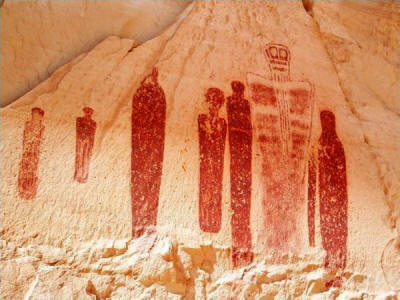
This picture comes from Horseshoe Canyon, otherwise known as Barrier
Canyon in Utah.
This seven-foot-high painting stands out among the
others because of its size.
It is part of the Great Gallery in
Horseshoe Canyon,
standing nearly life size next to a series of
other images.
Archeologists have struggled to
interpret the strange figures
that are depicted on the Great
Gallery.
With that said, here's
what the Cs had to say on 7 October 1994:
Q: (L) What is the source of the
Native American Indians?
A: Asia.
Q: (L) Across the Bering Strait?
A: No. Rescued. Transferred.
Q: (L) By whom?
A:
Grays.
Q: (L) What were they rescued out of?
A: Cataclysm.
Q: (L) When did that cataclysm occur?
A: 7200 years ago approx.
Q: (L) What was the nature of that cataclysm?
A: Comets.
Now, check out this below diagram.
According
to lexicostatistical analysis, the time depth from Yeniseian back to
its branching off from Dene-Caucasian (from which comes Na-Dene), is
just over 7000 years:
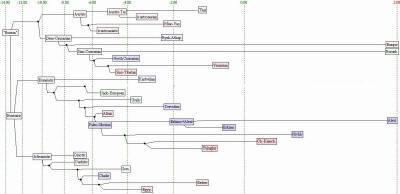
While we haven't been able to find any evidence indicating a comet
encounter in the Yenisei basin at the time indicated (incidentally,
this is where the famous
Tunguska airburst occurred in 1908),
catastrophe has been a prime mover in mass migrations (no pun
intended) throughout history, and the unusually large distance
between these two language groups is puzzling and suggests something
out of the ordinary to account for the branching of these groups.
So
while the 'transfer' idea is at this point mere speculation, it
remains 'interesting' nonetheless.
Keep the 7,200-year figure in
mind as we proceed.
Bright Omen,
Dark Age
Speaking of comets, the subject of cometary bombardment, both in
history and our future, is another that comes up a lot in the
Cassiopaean Experiment, and we'll probably be discussing it
frequently along the way.
While largely ignored by mainstream
academia and media, the phenomenon has great implications for our
understanding of history, the rise and fall of empires, and our
future, as new research has been showing in recent years.
Moving along to more recent history, these remarks from the session
on 12 September 1998 ended up proving to be quite the hit:
Q: (L) I have discovered that three
of the supernovas of antiquity which have been discovered and
time-estimated by the remnants, occurred in or near Cassiopeia
at very interesting points in history.
A: Yes...
Q: (L) Well, one of these periods in history was around 1054.
This is a very interesting time. It just so happens that there
are no European records of this supernova, which was recorded by
the Chinese, Japanese, and perhaps even the Koreans. Yet, there
are no European records. What happened to the European records?
A: Europe was in a "recovery mode" at the "time."
Q: (L) Recovery from what?
A: Loss of civilized structure due to overhead cometary
explosion in 564 AD.
Q: (L) What effect did this have on the civilized structure? Was
it a direct effect in terms of material, or did it have effects
on people causing them to behave in an uncivilized and barbaric
way?
A: Well, the
burning fragmentary shower ignited much of the land
areas in what you now refer to as Western Europe. This had the
results you can imagine, causing the resulting societal
breakdown you now refer to as "The Dark Ages."
Q: (L) Well, it damn sure was dark. There is almost a thousand
years that nobody knows anything about!
A: Check Irish or Celtic, and French or Gallic records of the
era for clues. There were temporary "islands of survival,"
lasting just long enough for the written word to eke out.
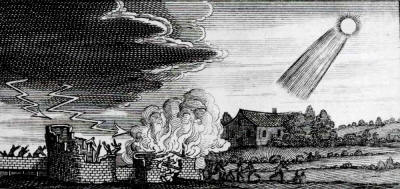
Woodcut showing destructive influence of
a comet,
dated to the fourth century AD,
from Stanilaus
Lubienietski's Theatrum Cometicum (Amsterdam, 1668)
A year after this session, on 17 August
1999, the Knight Ridder Washington Bureau published an article by
Robert S. Boyd entitled 'Comets may have caused Earth's great
empires to fall', which said:
"Recent scientific discoveries are
shedding new light on why great empires such as Egypt, Babylon and
Rome fell apart, giving way to the periodic "dark ages'' that
punctuate human history. At least five times during the last 6,000
years, major environmental calamities undermined civilizations
around the world."
Comparing the events to the fragments of
comet Shoemaker-Levy, which
impacted Jupiter with megatons of explosive energy, the researchers
say such impacts in earth's history produced dust clouds that dimmed
the Sun, cooled the earth and caused massive crop failure, hunger,
disease and death, as plague and famine spread through Italy, China
and the Middle East.
The previous order disintegrated, leading to
the paucity of historical, artistic and cultural remnants for such
periods.
The last such global crisis occurred between AD 530 and 540 - at the
beginning of the Dark Ages in Europe - when Earth was pummeled by a
swarm of cosmic debris. [...]
Dendrochronologist Mike Baillie
established with analysis of tree ring data that in 540 AD, in
different parts of the world, the climate changed. Temperatures
dropped enough to hinder the growth of trees as widely dispersed as
northern Europe, Siberia, western North America, and southern South
America.
A search of historical records and mythical stories pointed to a
disastrous visitation from the sky during the same period, it is
claimed. There was one reference [Roger of Wendover] to a "comet in
Gaul so vast that the whole sky seemed on fire" in 540-41.
According to legend, King Arthur died around this time, and Celtic
myths associated with Arthur hinted at bright sky Gods and bolts of
fire.
In the 530s, an unusual meteor shower was recorded by both
Mediterranean and Chinese observers.
Meteors are caused by the fine
dust from comets burning up in the atmosphere. Furthermore, a team
of astronomers from Armagh Observatory in Northern Ireland published
research in 1990 which said the Earth would have been at risk from
cometary bombardment between the years 400 and 600 AD.
Interestingly, it was a 'Celtic record' that gave Baillie the
confirmation he needed:
the dendrochronological record based on
Irish oaks - a continuous 7400-year-long record of tree ring growth
drawn from Irish trees - as well as records in the form of myth and
legend from the time in question.
Additionally, the Irish Annals
refer to two 'bread failures' during this small time window (famines
are also recorded in China, as well as the
Justinian plague that
spread from Egypt through Europe). (See Baillie, From Exodus to
Arthur [Batsford, 1999], p. 78)
Here are some of Baillie's
conclusions, from his book The Celtic Gods (Tempus, 2005),
co-authored with Patrick McCafferty:
It is possible that many stories about the exploits of saints may
simply be Christianized versions of older pagan tales, with Patrick
and Columcille replacing Lugh; but there is another option worth
considering: perhaps some of these deeds... actually took place
during the lifetime of the saints, in the sixth century.
This is
probably an appropriate point in this book to remind the reader of
the similarity between the Irish word for saint (niamh) and the word
for the sky or heaven (neamh).

It should be pointed out that, in 540, not only do we have lots of
churches founded in Ireland ["foundation sites had traditionally
been identified by objects falling from the skies"] by saints who
sound remarkably like pagan Celtic Comet gods, but throughout
Europe, churches are being established by saints such as St David,
St Michael and St George, better known for their skills at
vanquishing dragons [a common cometary symbol].
Furthermore... the
entire body of Arthurian legend also takes place at this same time.
[...]
Altogether, when one considers the expansion of the church, together
with the quasi-mythical activities of saints, kings and magicians,
and the problems faced by Irish oak trees, it is difficult to resist
the conclusion that the skies were indeed busy at this time. (p.
172)
The myths of the Celts are riddled with sky and comet imagery. Not
only do we find characters described like comets (and mistakenly
seen as sun gods by earlier scholars), but the times of year when
the earth passed through the Taurid meteor stream.
There are even
indications that the ages at which some of the principal characters
engage in the main events of their lives reflect the return times of
comets coming close to earth.
We are convinced that events in the
skies do indeed appear in the myths. (p. 175)
Just a Little
Bit of History Repeating
Perhaps relating to the figure of 7,200 years mentioned above, the
Cs had this to say on 30 September 1994:
Q: (L) Is there any regular
periodicity or cycle to this comet business?
A: Yes.
Q: (L) What is the period?
A: 3600 years roughly.
And this on 5 October 1994:
Q: (L) Now, this cluster of comets,
when was the last time it came into the solar system?
A: 3582 yrs ago?
Q: (L) What is the cycle?
A: 3600 yrs.
Q: (L) So, when is this cluster expected to hit the plane of the
ecliptic again?
A: 12 to 18 years.
If we keep in mind what we have learned
from Baillie - that comet bombardments are very likely to be one of
the main causes behind the collapse of empires throughout history -
we can use this to look for possible markers for this event.
Most recently, the following information
was published by the Proceedings of the National Academy of Sciences
in early 2009, and reported by the Associated Press in an article
titled 'Natural disasters doomed early Peruvian civilization 3,600
years ago':
Nature turned against one of America's early civilizations 3,600
years ago, when researchers say earthquakes and floods, followed by
blowing sand, drove away residents of an area that is now in Peru.
"This maritime farming community had been successful for over 2,000
years, they had no incentive to change, and then all of a sudden,
boom, they just got the props knocked out from under them,"
anthropologist Mike Moseley of the University of Florida said in a
statement.
Not so coincidentally, this matches with another date Baillie has
focused on as a possible cometary catastrophe with global effects:
1628 BC.
This date appears in ice core data, tree rings across
Europe and the Americas, in Babylonian and Chinese records (both of
which record possible evidence of a dust veil dimming the skies and
cooling the earth), and even one enigmatic reference to catastrophe
in the Irish Annals, although the far removal in time between the
event and the written record make it difficult to nail down with any
certainty (Baillie, 1999, p. 77).
This event may also coincide with
the fall of the Xia dynasty in China, when a comet was recorded in
Chinese records.
McCafferty and Baillie (2005, p. 34)
write:
c.1600 BC - Chinese record of two
suns in the sky [a common description of comets in ancient
records], one to the east and one to the west, just before the
overthrow of King Chieh and the demise of his Hsia dynasty.
Chieh is reported to have said,
"When that (the second) sun
dies, you and I, we'll all perish."
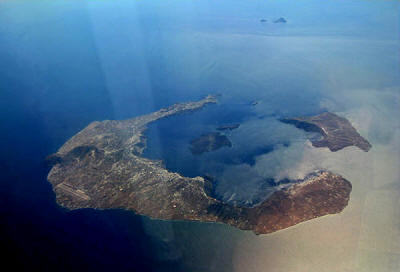
View of Santorini from the air
Baillie argues 1628 BC for the true date of the eruption of
Santorini, which brought down the Bronze Age Minoan civilization
that had thrived for over a millennium and probably coincided with
either the beginning or the end of the Second Intermediate period in
Egypt (the period of so-called 'Hyksos' rule).
This was a controversial position to
take when it was first proposed in the late 1980s, because it called
for a revision of Egyptian chronology, pointing out some of the
problems of history mentioned at the beginning of this article.
Egyptian chronology is largely dependent on Biblical chronology,
which has largely been discredited in recent years.
Archaeology, in
turn, has largely relied on this 'established' chronology to
calibrate itself.
There are no firmly established anchors or markers
with which to calibrate ancient history. Those that are commonly
used are actually vague astronomical references that can refer to
several different dates, or are too fragmentary to provide any solid
date.
As archaeologist and historian Colin Renfrew put it in his
introduction to Peter James' book Centuries of Darkness (Rutgers,
1993):
The first step... is to recognize the depths of our ignorance. To
realize how the existing 'chronologies' in different parts of the
Mediterranean are bolstered up by circular arguments, where
specialists in one area believe that those in other areas must know
what they are talking about, and blindly use dating systems which
are no better than their own.
(p. xv)
In short, nothing is certain that far back in time, yet the dates we
all learn in school and university are taken for granted, even by
the professionals.
However, most mainstream historians have accepted
the date for
Santorini in recent years based on the more robust
nature of the scientific evidence, as opposed to the imprecise
'Biblical-chronological' methods.
Santorini could be one such anchor
to help calibrate the timeline, but it remains to be seen how far
historians will go in their revision of the accepted chronology.
Also, historians are increasingly acknowledging climatic factors in
explaining the periods of economic affluence and depressions
discernible in the historical records for this time.
On this
subject, historian Thomas L. Thompson writes, with typical academic
understatement:
Each successive period - Early Bronze IV, Middle Bronze II/Late
Bronze I, Iron I, and the early 'Persian' period - finds its fate in
economic collapse and a dramatic Malthusian culling of the
population. It is these periods that most require historical
explanation, for these depressions are departures from the expected.
(The Mythic Past [Perseus, 1999], p. 135)
For reference, here are the accepted dates for these periods
mentioned by Thompson:
Note that the 1550 BC
figure falls within the period under contention in regards to the
date of Santorini and its conflict with the previously accepted
chronology. (On a related note, a
recent radiocarbon analysis of the
beginning of the Egyptian New Kingdom pushed it back as many as
twenty years, to 1570 BC.)
With those dates in mind, here are the
dates Baillie has identified as comet-induced global climate
catastrophes based on tree-ring data (as well ice core data,
historical and archaeological records):
2345 BC, 1628 BC, and 1159
BC.
Fascinating, huh?
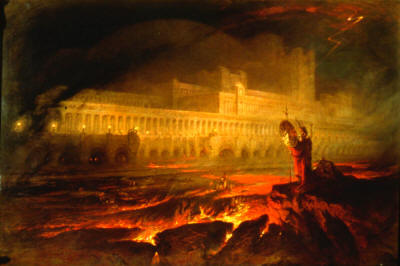
John Martin's
'Pandemonium'
The
Bronze Age Collapse (ca. 1150 BC) saw the demise of the Mycenean
kingdoms, the Hittite empire in Anatolia and Syria, the Egyptian
empire in Syria and Canaan, and the mass destruction of scores of
cities in the Middle East.
Baillie writes (1999):
Sometimes near or in the twelfth century BC, allowing for
flexibility in archaeological and ancient historical evidence, the
whole fabric of ancient society appears to have crumbled.
Some have
suggested that in most of Britain there was upland abandonment,
particularly severe in Scotland, followed by an upsurge in the
construction of defensive sites. Around the Mediterranean there was
an endless list of movements and collapses. Most interesting was the
demise of the Mycenaean civilization in Greece with the ensuing
four-century 'Greek Dark Age' which descended on the Mediterranean
region.
Here was an extremely dramatic decline where people had
already argued for some sort of environmental 'event' involving a
prolonged and highly regionalized drought.
(p. 71)
The 1159 downturn in climate is commonly dated to the beginning of
the end of the Twentieth Dynasty, the reign of Ramesses III:
a time
of drought, famine, political corruption, expensive wars and civil
unrest.
As Wikipedia
puts it,
"Something in the air prevented much
sunlight from reaching the ground [HK: How is that for cosmic
symbolism?] and also arrested global tree growth for almost two full
decades until 1140 BC. One proposed cause is the Hekla 3 eruption of
the Hekla volcano in Iceland but the dating of this remains
disputed."
Or comet dust/debris, perchance?
Historian John Van Seters, writing in 1966, before the impact of
climate and catastrophe figured much into the analysis of these
periods of history, had this to say on the earlier MB II/LB I
transition:
The end of the Middle Bronze Age is clear and undisputed. Here the
break is not a cultural one, for there is definite continuity in
architecture, pottery, and art.
The division is characterized by
widespread destruction of a number of sites in southern Palestine
and by the appearance of new pottery styles in addition to older
forms.
The destructions can best be understood as the activity of
the Eighteenth Dynasty pharaohs and the date for the end of Middle
Bronze would be about 1550 B.C.
(The Hyksos [Wipf and Stock, 2010],
p. 9)
Van Seters argues that this period coincides with the end of Hyksos
rule/Second Intermediate Period, not the beginning, possibly giving
us an anchor (1628 BC) with which to solidify an accurate chronology
of the time, although Egyptian chronology is a mess when you
actually dig into it.
The Egyptian New Kingdom, which sprung up
after the Hyksos fell, lasted 479 years according to historians,
from 1550-1069 BC. (Incidentally, this is also the length of time
traditionally given for the 'Israelite Exodus'.) Perhaps not so
coincidentally, the time between the two climatic downturns
identified by Baillie is 469 years: 1628-1159 BC.
This is also close
to the time calculated between the falls of the Xia and Shang
dynasties in China (anywhere from 496 to 554 years, depending on who
you ask). Baillie devotes an appendix to this issue, and argues that
the dates for the dynasties would be better matched to the periods
mentioned, although this too is a contentious issue.
As for the EB IV/MB I transition (2100 BC), this period saw the
beginning of the first 'dark age' or Intermediate Period in Egyptian
history, for which relatively little evidence survives. Here's what
Van Seters has to say about it:
The coming of the MB I people into Transjordan does not, as in
Palestine, represent an invasion and sudden destruction of the
previous EB III civilization. It is instead an immigration and
settling, for the most part, on previously uninhabited sites...
The first phase of the new immigration is often known as EB IV
because it is contemporaneous with the last of the EB peoples of
Palestine and Transjordan... The mixture of ceramic styles of EB IV
and MB I cannot be easily distinguished stratigraphically in
Transjordan ... The decline of [EB IV/]MB I in Transjordan and the
Negev is catastrophic...
In fact there is a general absence of
sedentary life for several hundred years. Likewise in Palestine, MB
I was very likely followed by a gap in settlement, but of a much
shorter duration.
(p. 13)
Summing up, the evidence for a cometary catastrophe ca. 1600 BC is
fairly strong, at least according to Baillie. If the Cs are right
about a 3,600-year cycle, we're overdue another encounter.
Even if
they're wrong about the cycle, the scientific record is showing that
such encounters are anything but extraordinary.
As the article quoted above stated,
"At least five times during the last
6,000 years, major environmental calamities undermined
civilizations around the world."
Those aren't very good odds...
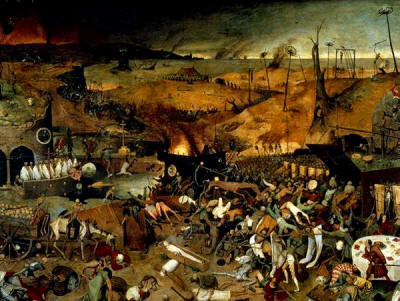
Hell on Earth, the
nightmare depicted by Flemish painter Pieter Bruegel
in his
mid-16th-century 'The Triumph of Death' reflects the social upheaval
and terror
that followed the
plague that devastated medieval Europe.
Was there a cosmic
connection?
|


























